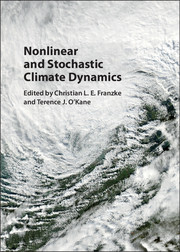Book contents
- Frontmatter
- Contents
- List of Figures
- List of Contributors
- Preface
- 1 Challenges for Ice Age Dynamics: A Dynamical Systems Perspective
- 2 Tipping Points in the Climate System
- 3 Atmospheric Teleconnection Patterns
- 4 Atmospheric Regimes: The Link between Weather and the Large-Scale Circulation
- 5 Low-Frequency Regime Transitions and Predictability of Regimes in a Barotropic Model
- 6 Complex Network Techniques for Climatological Data Analysis
- 7 On Inference and Validation of Causality Relations in Climate Teleconnections
- 8 Stochastic Climate Theory
- 9 Stochastic Subgrid Modelling for Geophysical and Three-Dimensional Turbulence
- 10 Model Error in Data Assimilation
- 11 Long-Term Memory in Climate: Detection, Extreme Events, and Significance of Trends
- 12 Fractional Stochastic Models for Heavy Tailed, and Long-Range Dependent, Fluctuations in Physical Systems
- 13 Modelling Spatial Extremes Using Max-Stable Processes
- 14 Extreme Value Analysis in Dynamical Systems: Two Case Studies
- Index
9 - Stochastic Subgrid Modelling for Geophysical and Three-Dimensional Turbulence
Published online by Cambridge University Press: 26 January 2017
- Frontmatter
- Contents
- List of Figures
- List of Contributors
- Preface
- 1 Challenges for Ice Age Dynamics: A Dynamical Systems Perspective
- 2 Tipping Points in the Climate System
- 3 Atmospheric Teleconnection Patterns
- 4 Atmospheric Regimes: The Link between Weather and the Large-Scale Circulation
- 5 Low-Frequency Regime Transitions and Predictability of Regimes in a Barotropic Model
- 6 Complex Network Techniques for Climatological Data Analysis
- 7 On Inference and Validation of Causality Relations in Climate Teleconnections
- 8 Stochastic Climate Theory
- 9 Stochastic Subgrid Modelling for Geophysical and Three-Dimensional Turbulence
- 10 Model Error in Data Assimilation
- 11 Long-Term Memory in Climate: Detection, Extreme Events, and Significance of Trends
- 12 Fractional Stochastic Models for Heavy Tailed, and Long-Range Dependent, Fluctuations in Physical Systems
- 13 Modelling Spatial Extremes Using Max-Stable Processes
- 14 Extreme Value Analysis in Dynamical Systems: Two Case Studies
- Index
Summary
Abstract
Stochastic modelling and closure-based approaches to the representation of the effects of subgrid turbulence in large eddy simulations (LES) of turbulent fluids are reviewed. The focus is on methods in which the subgrid model is calculated self-consistently from higher resolution benchmark simulations or closures. Eddy viscosity and stochastic backscatter parametrisations are presented for two-dimensional turbulence of barotropic flows, for baroclinic quasi-geostrophic turbulence of the atmosphere and oceans, for atmospheric flows in multi-level primitive equation models and for three-dimensional boundary layer turbulence in channels. The performance of LES with these parametrisations is examined. Subgrid scale parametrisations for the complex problem of inhomogeneous flows over topography are also analysed.
Introduction
Recent progress in the development of parametrisations of subgrid scale turbulence for large eddy simulations (LES) of geophysical and three-dimensional flows is reviewed. The classes of subgrid interactions with the resolved scales for turbulent flows over topography were detailed by Frederiksen (1999, 2012a,b) and include eddy-eddy, eddy-meanfield, meanfield-meanfield, eddy-topographic and meanfield-topographic. Our main focus is on approaches where the subgrid terms are determined self-consistently from high-resolution benchmark closures or the statistics of direct numerical simulations (DNS). Unlike traditional methods of subgrid scale parametrisation no tuning parameters are employed in the LES. A brief historical introduction to the different approaches for developing subgrid models is also presented.
Deterministic Parametrisations for Atmospheric Flows
It has been clear since the very first atmospheric climate simulations that the accuracy of the large-scale flows and energy spectra is dependent upon the modelling of the subgrid processes (Smagorinsky, 1963). In its most basic form, subgrid modelling prescribes the relationship between the resolved field and the subgrid tendency, which is the contribution of the subgrid interactions to the evolution of the resolved field. One of the most widely adopted and celebrated models is the empirical Smagorinsky model (Smagorinsky, 1963), in which the subgrid stress tensor is related to the local strain rate (symmetric part of the velocity gradient tensor) via a single specified parameter. This model is more appropriate for three-dimensional turbulence than for quasi-geostrophic (QG) turbulence, where the subgrid dissipation operator typically takes the form of the Laplacian raised to a specified power.
- Type
- Chapter
- Information
- Nonlinear and Stochastic Climate Dynamics , pp. 241 - 275Publisher: Cambridge University PressPrint publication year: 2017
- 8
- Cited by

